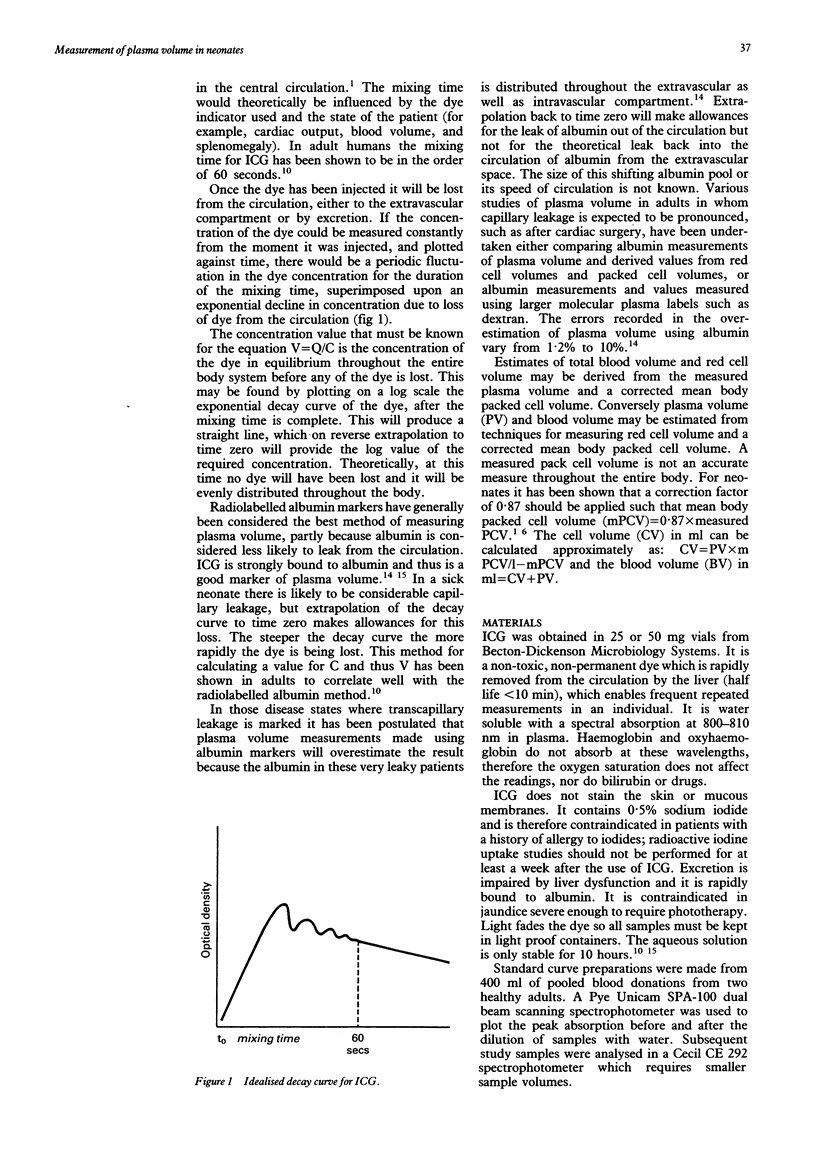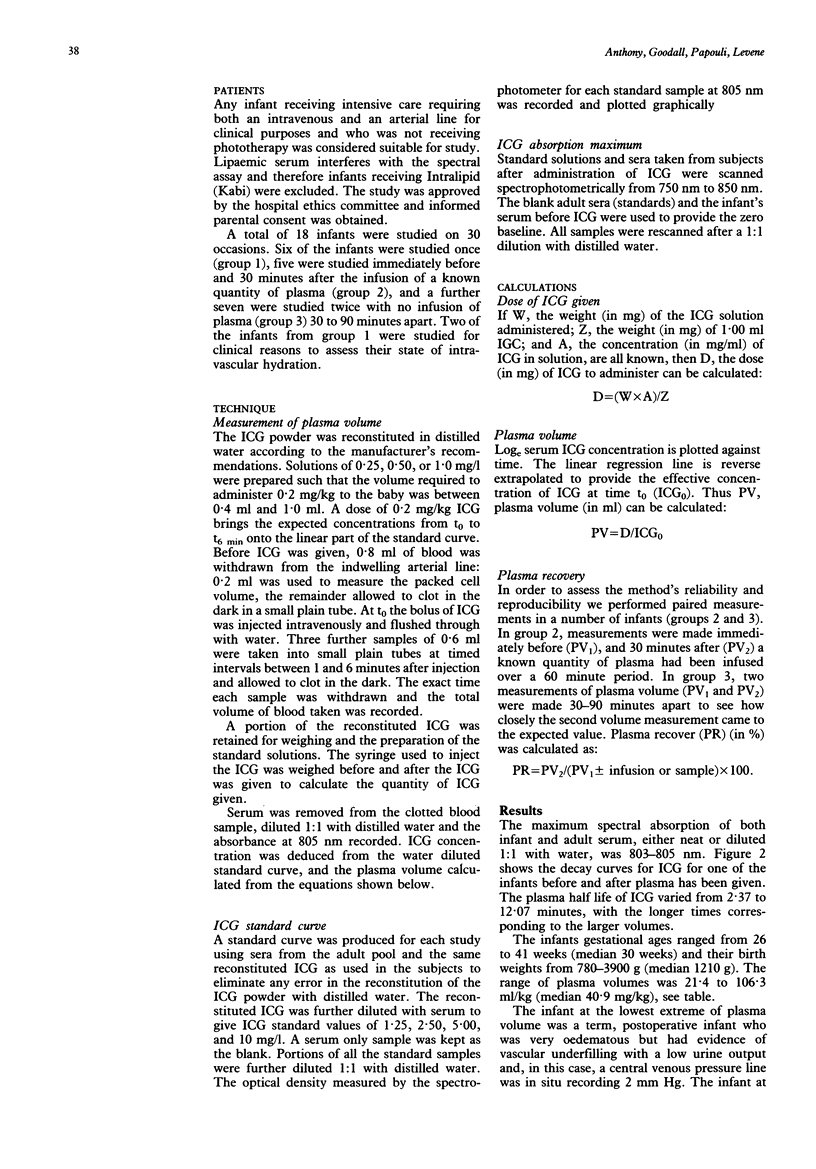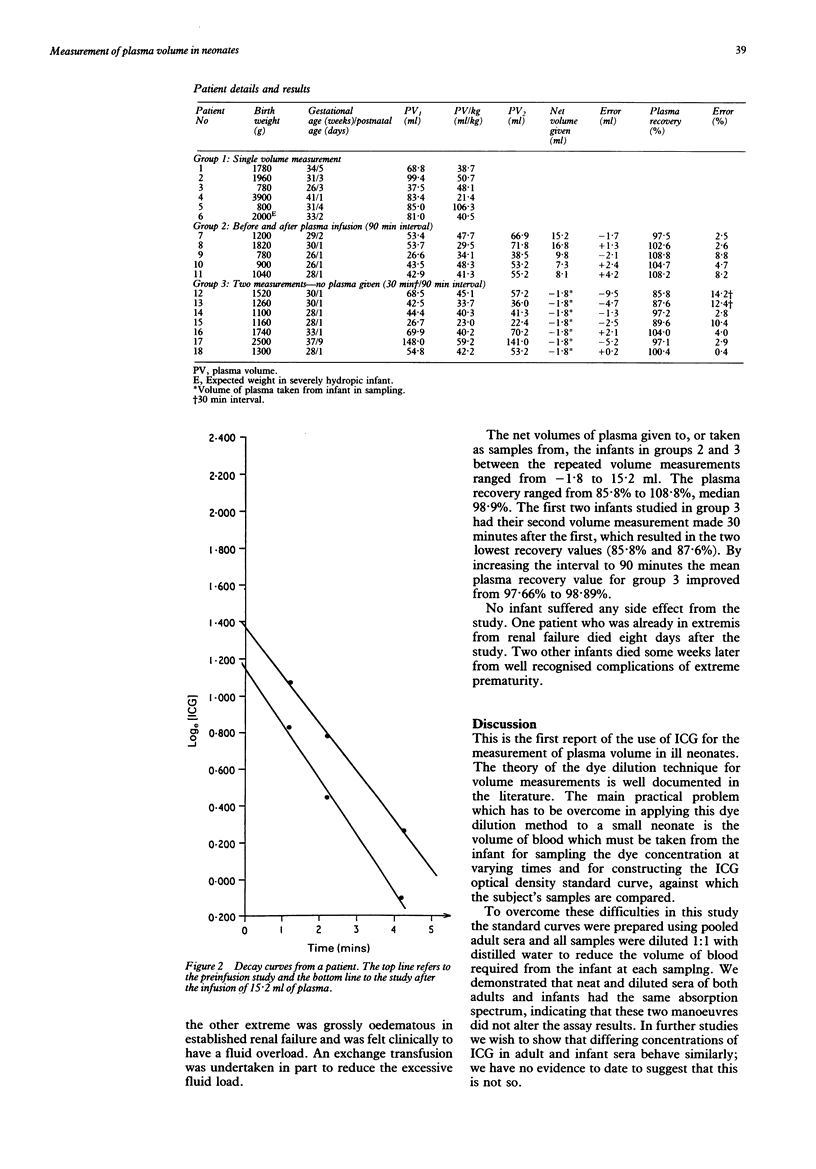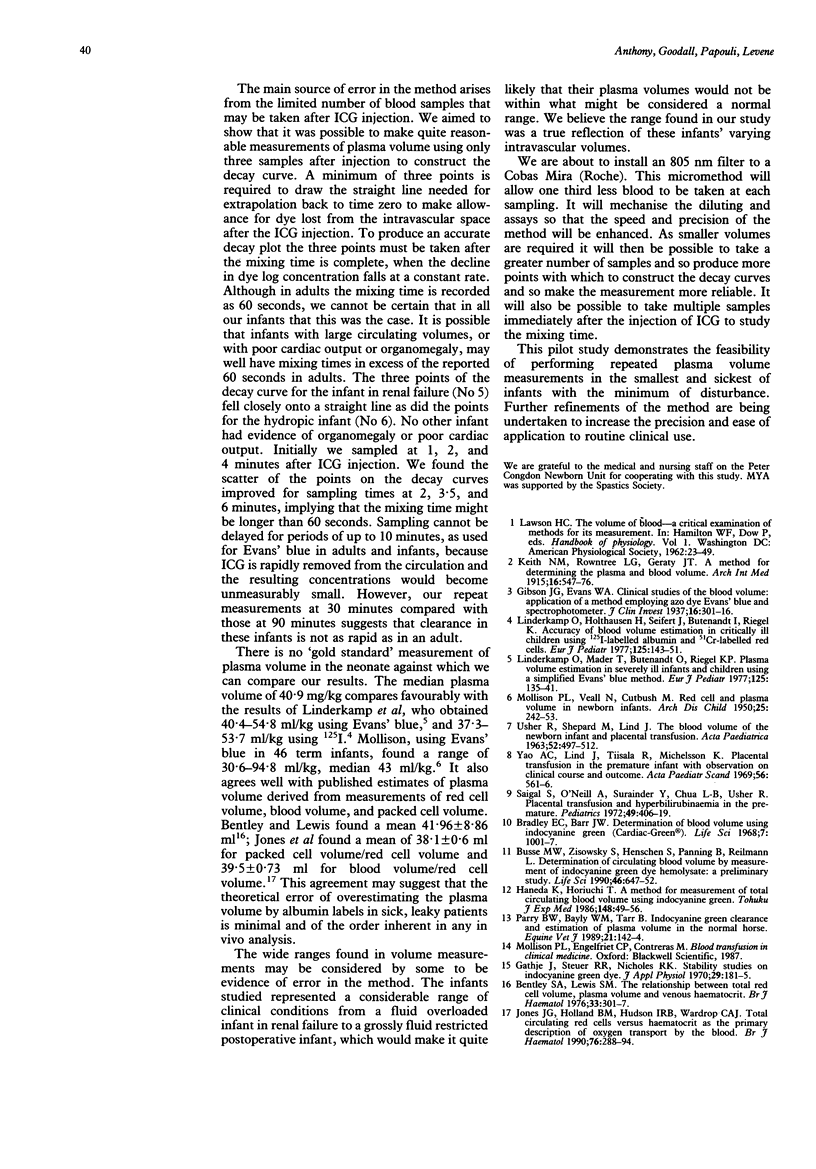Abstract
There is no reliable and safe method for measuring plasma volume in ill newborn infants. We describe an adaptation of the dye dilution technique using indocyanine green as the plasma label, which can be used in the sickest and smallest of infants with the minimum of disturbance. To avoid the need to take large volumes of blood from the infant, samples were diluted 1:1 with distilled water and pooled adult sera was used to construct the dye dilution standard curves. Eighteen preterm and fullterm infants were studied on 30 occasions. The measured plasma volume ranged between 21.4 and 106 ml/kg. Paired measurements were performed within 30-90 minutes of each other in seven infants. In five infants estimations of plasma volume were made shortly before and 30 minutes after the infusion of a known quantity of plasma. In eight out of 12 infants who had two measurements made there was close agreement between the second measured volume and the first measured volume, taking into account how much plasma had been given to or taken from the infant between the two measurements. The error ranged from 0.2 to 5.2 ml and the plasma recovery error ranged from -2.9% to +4.7%. In the remaining four infants the errors ranged from 2.1 to 9.5 ml and -14.2% to +8.8%. Errors in the measurement of plasma volume may arise as the result of sampling too early before full mixing of the dye has occurred, and there is a potential error in the measurement due to the distribution of albumin in the extracellular space in sick infants resulting in an overestimation of the plasma volume. Proposals for reducing sources of errors are discussed.
Full text
PDF




Selected References
These references are in PubMed. This may not be the complete list of references from this article.
- Bentley S. A., Lewis S. M. The relationship between total red cell volume, plasma volume and venous haematocrit. Br J Haematol. 1976 Jun;33(2):301–307. doi: 10.1111/j.1365-2141.1976.tb03542.x. [DOI] [PubMed] [Google Scholar]
- Bradley E. C., Barr J. W. Determination of blood volume using indocyanine green (cardio-green) dye. Life Sci. 1968 Sep 1;7(17):1001–1007. doi: 10.1016/0024-3205(68)90108-2. [DOI] [PubMed] [Google Scholar]
- Busse M. W., Zisowsky S., Henschen S., Panning B., Reilmann L. Determination of circulating blood volume by measurement of indocyanine green dye in hemolysate: a preliminary study. Life Sci. 1990;46(9):647–652. doi: 10.1016/0024-3205(90)90133-c. [DOI] [PubMed] [Google Scholar]
- Gathje J., Steuer R. R., Nicholes K. R. Stability studies on indocyanine green dye. J Appl Physiol. 1970 Aug;29(2):181–185. doi: 10.1152/jappl.1970.29.2.181. [DOI] [PubMed] [Google Scholar]
- Gibson J. G., Evans W. A. CLINICAL STUDIES OF THE BLOOD VOLUME. I. CLINICAL APPLICATION OF A METHOD EMPLOYING THE AZO DYE "EVANS BLUE" AND THE SPECTROPHOTOMETER. J Clin Invest. 1937 May;16(3):301–316. doi: 10.1172/JCI100859. [DOI] [PMC free article] [PubMed] [Google Scholar]
- Haneda K., Horiuchi T. A method for measurement of total circulating blood volume using indocyanine green. Tohoku J Exp Med. 1986 Jan;148(1):49–56. doi: 10.1620/tjem.148.49. [DOI] [PubMed] [Google Scholar]
- Jones J. G., Holland B. M., Hudson I. R., Wardrop C. A. Total circulating red cells versus haematocrit as the primary descriptor of oxygen transport by the blood. Br J Haematol. 1990 Oct;76(2):288–294. doi: 10.1111/j.1365-2141.1990.tb07886.x. [DOI] [PubMed] [Google Scholar]
- Linderkamp O., Holthausen H., Seifert J., Butenandt I., Riegel K. P. Accuracy of blood volume estimations in critically ill children using 125I-labelled albumin and 51Cr-labelled red cells. Eur J Pediatr. 1977 Jun 1;125(2):143–151. doi: 10.1007/BF00489987. [DOI] [PubMed] [Google Scholar]
- Linderkamp O., Mader T., Butenandt O., Riegel K. P. Plasma volume estimation in severely ill infants and children using a simplified Evans blue method. Eur J Pediatr. 1977 Jun 1;125(2):135–141. doi: 10.1007/BF00489986. [DOI] [PubMed] [Google Scholar]
- MOLLISON P. L., VEALL N., CUTBUSH M. Red cell and plasma volume in newborn infants. Arch Dis Child. 1950 Sep;25(123):242–253. doi: 10.1136/adc.25.123.242. [DOI] [PMC free article] [PubMed] [Google Scholar]
- Parry B. W., Bayly W. M., Tarr B. Indocyanine green clearance and estimation of plasma volume in the normal horse. Equine Vet J. 1989 Mar;21(2):142–144. doi: 10.1111/j.2042-3306.1989.tb02123.x. [DOI] [PubMed] [Google Scholar]
- Saigal S., O'Neill A., Surainder Y., Chua L. B., Usher R. Placental transfusion and hyperbilirubinemia in the premature. Pediatrics. 1972 Mar;49(3):406–419. [PubMed] [Google Scholar]
- USHER R., SHEPHARD M., LIND J. THE BLOOD VOLUME OF THE NEWBORN INFANT AND PLACENTAL TRANSFUSION. Acta Paediatr. 1963 Sep;52:497–512. doi: 10.1111/j.1651-2227.1963.tb03809.x. [DOI] [PubMed] [Google Scholar]
- Yao A. C., Lind J., Tiisala R., Michelsson K. Placetal transfusion in the premature infant with observation on clinical course and outcome. Acta Paediatr Scand. 1969 Nov;58(6):561–566. doi: 10.1111/j.1651-2227.1969.tb04762.x. [DOI] [PubMed] [Google Scholar]


